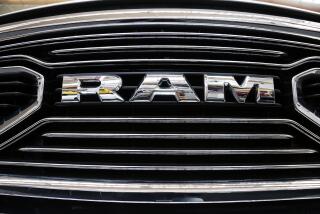Four Major Corporations Agree to Reduce or End Release of Ozone-Depleting CFCs
- Share via
WASHINGTON — Four giant corporations, responding to growing consumer and governmental concern about the damage that chlorofluorocarbons do to the Earth’s protective ozone layer, have announced over the last week that they will cut back or end their release of the chemicals.
General Motors said that by 1991 it will require its 10,000 car dealers to recycle CFCs purged from automobile air conditioners undergoing servicing.
Nissan Motors said that it will end the use of CFCs entirely in its air conditioners by 1993, replacing the coolant with an alternative that does not attack ozone.
Sharp Cutback by AT&T;
AT&T;, which uses CFC solvents and coolants in hundreds of processes, said that it will cut the volume used by 50% by 1991 and end CFC use entirely by 1994.
And GE agreed , after negotiations with Sen. Albert Gore Jr. (D-Tenn.), to offset its much criticized release of 300,000 pounds of CFCs from a nationwide refrigerator repair program by cutting back on releases elsewhere.
Together, the actions portend a gloomy future for CFCs in manufacturing industries, many of which have been slow to respond to the calls of environmentalists to eliminate them. But many corporations are taking their own action, prodded by pending legislation in Congress and several state legislatures, increasingly organized and vocal environmental groups and mounting public outrage over the issue.
CFCs, used in a wide range of manufacturing processes from refrigeration to solvents, are considered something of a wonder chemical because they are non-toxic, non-flammable and stable. But the chemicals are also the prime destroyer of the ozone layer high in the atmosphere that protects Earth’s surface from too much ultraviolet radiation.
As the ozone layer thins, increases are expected in the incidence of skin cancer, cataracts, depressed human immune systems and reduced crop yields. CFCs are also a culprit in the global warming trend, often called the “greenhouse effect.”
“The door on CFCs is going to close, and they are going to be highly regulated if not outright prohibited sooner than later,” AT&T; engineering vice president Dave Chittick said. “And, the way we see it, if you don’t know you have a problem you aren’t looking for a solution.”
Chittick said AT&T; is experimenting with a substitute made from citrus rinds that shows promise in replacing CFCs to clean electronic components.
General Motors and Nissan said that they were dealing with CFCs from car air conditioners, which are a major contributor to CFC build-up.
The standard repair practice, which is legal and common, is to vent CFCs into the air and recharge the unit with new coolant. GM said it will make a recycling machine available to its dealers this year.
Nissan said it would end use of CFCs by replacing them with hydrochlorofluorocarbons, related compounds that are said not to release ozone-depleting elements when they evaporate. It will also replace CFCs, which dry instantly, with water as a cleaning solvent. “We wanted to be a leader,” Nissan spokesman Don Spetner said, “and, with the pending legislation, we knew we had to move quickly.”
Gore, along with other politicians in both the House and Senate, has introduced legislation to reduce and eventually ban ozone-depleting chemicals. State legislatures in Vermont and Hawaii have enacted similar legislation. And 50% of CFCs are to be phased out worldwide by the end of the century under an international agreement.
Gore called GE’s decision “ground-breaking” because it would mean “real reductions in the volume of CFCs now being released into our air.”
GE’s $450-million program to repair more than a million refrigerators sold in 1987 and 1988 began when it was found that the compressors were faulty. While fixing the units in customers’ kitchens, GE has been intentionally releasing about five ounces of CFCs from each unit.
More to Read
Inside the business of entertainment
The Wide Shot brings you news, analysis and insights on everything from streaming wars to production — and what it all means for the future.
You may occasionally receive promotional content from the Los Angeles Times.










